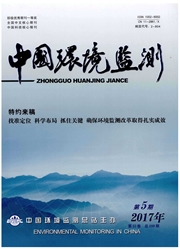

 中文摘要:
中文摘要:
2014年11月—2015年1月对西宁市冬季开展PM2.5和PM10的连续监测。利用DRI 2001A型热光碳分析仪(美国)对有机碳和元素碳进行分析,结果表明:西宁市冬季PM2.5和PM10中碳气溶胶所占比例分别为33.13%±6.83%、24.21%±6.27%,说明碳气溶胶主要集中在PM2.5中;OC/EC值均大于2,说明西宁市大气中存在二次污染;SOC占PM2.5和PM10的质量浓度比例分别为46.50%和57.40%,PM2.5中SOC浓度占PM10中SOC浓度的61.88%,说明SOC主要存在于PM2.5中,且SOC形成的二次污染和直接排放的一次污染都是西宁市碳气溶胶的主要来源;与其他城市比较发现,西宁市冬季PM2.5中的碳气溶胶含量普遍高于其他城市,PM10中OC质量浓度相对其他城市较高,EC质量浓度偏低;OC和EC的相关性不显著,说明来源不统一;进一步对OC和EC各组分质量浓度进行分析知,西宁市冬季碳气溶胶主要来源于机动车汽油排放、燃煤和生物质燃烧。
 英文摘要:
英文摘要:
PM2.5and PM10 were monitored continuously from November,2014 to January,2015. Organic carbon and elemental carbon were measured by DRI 2001 A,which from the Desert Research Institute in the United States. The results show that the ratios of TC in PM2.5and PM10 are 33. 13% ± 6. 83%,24. 21% ± 6. 27%,TC Mainly concentrated in PM2.5in Xining Winter.The ratio of OC / EC is over 2,that is to say secondary pollution exists in Xining Winter. The ratios of secondary organic carbon( SOC) in PM2.5and PM10 are 46. 50%,57. 40%,the mass concentration of SOC in PM2.5account for 61. 88% of SOC in PM10,thatmeans SOC mainly in the PM2.5,the secondary pollution and the original pollution are all the mainly pollute resources of carbon aerosol in Xining Winter. Compared with other cities,the mass concentration of carbon aerosol in PM2.5are higher than most of the other cities,the mass concentration of OC in PM10 are higher than most of the other cities,but EC are lower. The correlation between OC and EC is not significant,so the source of OC and EC is not uniform. Analyzed the mass concentration of components of OC and EC know carbon aerosol mainly comes from coal combustion,vehicle exhaust and biomass burning in Xining Winter.
 同期刊论文项目
同期刊论文项目
 同项目期刊论文
同项目期刊论文
 期刊信息
期刊信息
